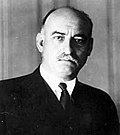| No. | Portrait | Minister | Took office | Left office | Time in office | Party |
|---|
| 1 | | Trifković, Marko Marko Trifković
(1864–1928) | 1 December 1918 | 20 December 1918 | 19 days | NRS |
| 2 | | Pribićević, Svetozar Svetozar Pribićević
(1875–1936) | 20 December 1918 | 19 February 1920 | 1 year, 61 days | DS |
| (1) | | Trifković, Marko Marko Trifković
(1864–1928) | 19 February 1920 | 16 May 1920 | 87 days | NRS |
| 3 | | Davidović, Ljubomir Ljubomir Davidović
(1863–1940) | 16 May 1920 | 1 January 1921 | 230 days | DS |
| 4 | | Drašković, Milorad Milorad Drašković
(1873–1921) | 1 January 1921 | 21 July 1921 † | 201 days | DS |
| (2) | | Pribićević, Svetozar Svetozar Pribićević
(1875–1936) | 21 July 1921 | 24 December 1921 | 156 days | DS |
| 5 | | Marinković, Vojislav Vojislav Marinković
(1876–1935) | 24 December 1921 | 24 June 1922 | 182 days | DS |
| 6 | | Vujičić, Milorad Milorad Vujičić
(1869–1936) | 17 December 1922 | 27 March 1924 | 1 year, 101 days | NRS |
| 7 | | Srškić, Milan Milan Srškić
(1880–1937) | 27 March 1924 | 28 July 1924 | 123 days | NRS |
| 8 | | Petrović, Nastas Nastas Petrović
(1867–1928) | 28 July 1924 | 6 November 1924 | 101 days | NRS |
| 9 | | Maksimović, Božidar Božidar Maksimović
(1886–1969) | 6 November 1924 | 17 April 1927 | 2 years, 162 days | NRS |
| 10 | | Vukićević, Velimir Velimir Vukićević
(1871–1930) | 17 April 1927 | 13 January 1928 | 271 days | NRS |
| 11 | | Radović, Čedomir Čedomir Radović | 13 January 1928 | 23 February 1928 | 41 days | ? |
| 12 | | Korošec, Anton Anton Korošec
(1872–1940) | 28 February 1928 | 7 January 1929 | 314 days | SLS |
| 13 | | Živković, Petar Petar Živković
(1879–1953) | 7 January 1929 | 5 January 1932 | 2 years, 363 days | JNS |
| (7) | | Srškić, Milan Milan Srškić
(1880–1937) | 5 January 1932 | 11 July 1932 | 188 days | JNS |
| 14 | | Lazić, Živojin Živojin Lazić
(1876–1958) | 11 July 1932 | 22 December 1934 | 2 years, 164 days | JNS |
| 15 | | Popović, Velimir Velimir Popović | 22 December 1934 | 24 June 1935 | 184 days | JNS
JRZ |
| (12) | | Korošec, Anton Anton Korošec
(1872–1940) | 24 June 1935 | 21 December 1938 | 3 years, 180 days | SLS |
| 16 | | Aćimović, Milan Milan Aćimović
(1898–1945) | 21 December 1938 | 5 February 1939 | 46 days | JRZ |
| 17 | | Cvetković, Dragiša Dragiša Cvetković
(1893–1969) | 5 February 1939 | 26 August 1939 | 202 days | JRZ |
| 18 | | Mihaldžić, Stanoje Stanoje Mihaldžić
(1892–1956) | 26 August 1939 | 8 July 1940 | 317 days | JRZ |
| (17) | | Cvetković, Dragiša Dragiša Cvetković
(1893–1969) | 8 July 1940 | 27 March 1941 | 262 days | JRZ |
| 19 | | Budisavljević, Srđan Srđan Budisavljević
(1883–1968) | 27 March 1941 | 18 April 1941 | 22 days | SDS |
































